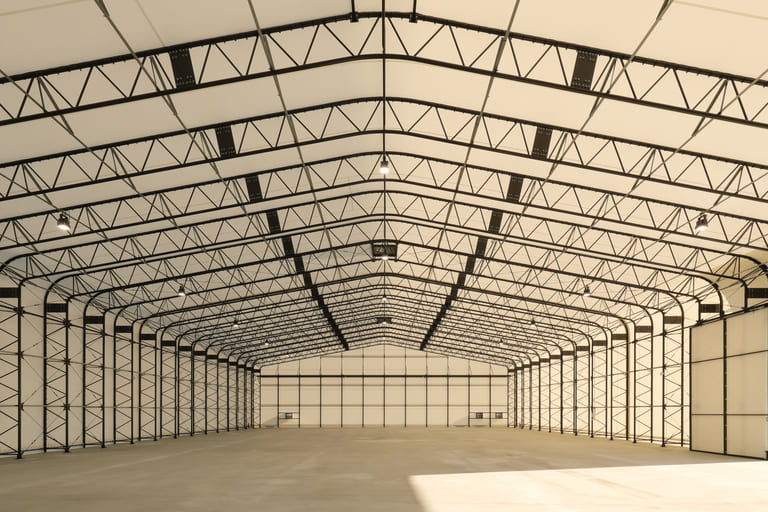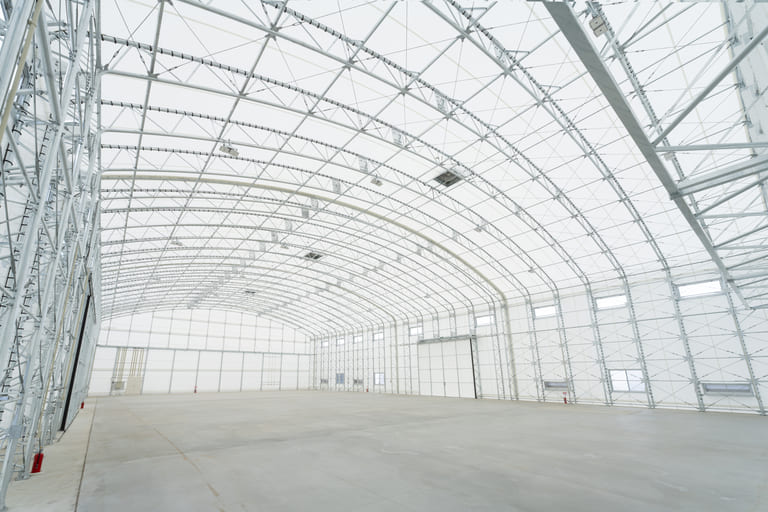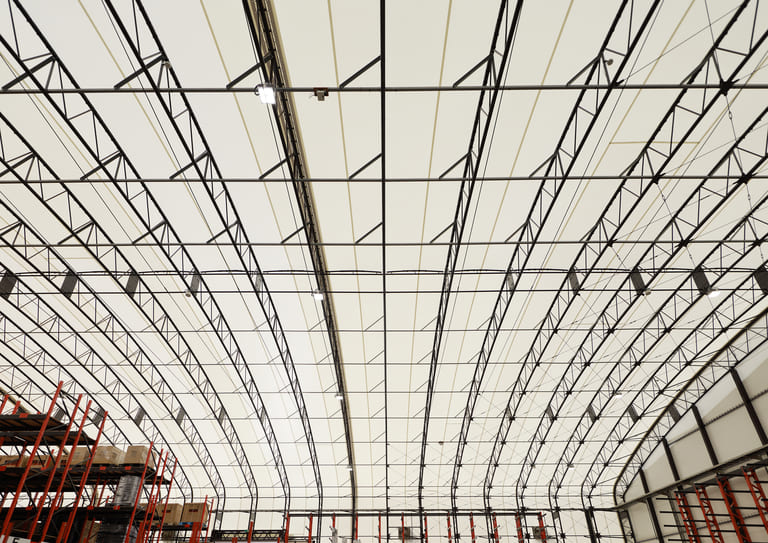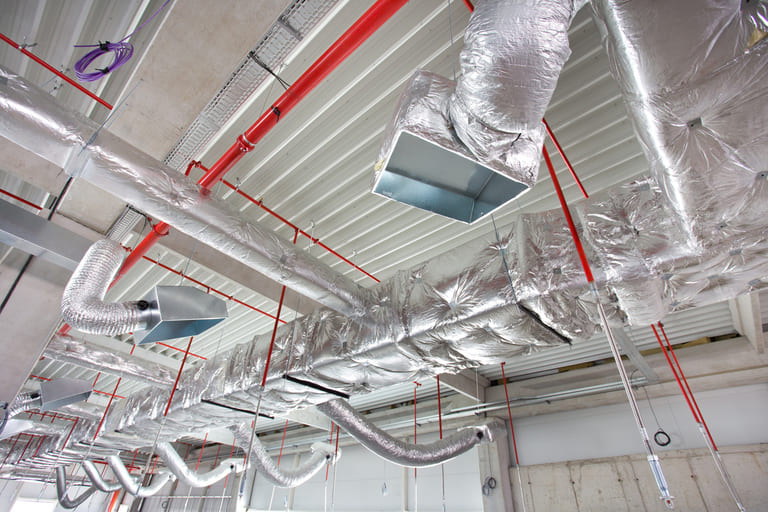

Taiyo Kogyo Column
What are the disadvantages of tent warehouses and how to avoid mistakes? Even the notable advantages are explained.
2025.05.01

Tent warehouses are attractive because they can be installed quickly and inexpensively. For this reason, many companies use them as warehouses and workshops.
However, when compared to conventional, prefabricated, and system warehouses, there are some disadvantages that should be noted.
This article details the advantages and disadvantages of tent warehouses and also introduces measures to avoid failure.
Please use it as a reference for building a better tent warehouse.
>> Click here to visit our website specializing in “Tent Warehouses”.
What is a tent warehouse?

A tent warehouse is a simple warehouse with a lightweight framework covered with a sheet membrane.
The tent-like structure is designed to be simpler and more efficient than conventional buildings.
As a result, the warehouse can be constructed in a shorter period of time than a conventional warehouse, significantly reducing delivery time.
It also offers a high degree of design flexibility and can accommodate a variety of formats, including folding and sliding types.
It is easy to install and can be flexibly utilized even in small spaces or limited site conditions.
An additional benefit is that the sheet material walls and roof provide excellent lighting, allowing work to be done during the day without the use of lighting.
Because of these characteristics, tent warehouses are widely used, especially for storing goods in factories and distribution centers.
What are the disadvantages of tent warehouses?

The disadvantages of tent warehouses will now be explained in detail. Please take a look at them along with the countermeasures.
Deterioration of tent fabric
While tent warehouses are lightweight and easy to set up, deterioration of the tent fabric is inevitable.
It is susceptible to damage from ultraviolet rays and outside air, especially the roof area, which is exposed to sunlight.
In coastal areas, sea breezes and strong sunlight can further accelerate deterioration.
Typical useful life is 10 to 20 years, but varies depending on location and materials.
Proper maintenance and replacement is required when damage occurs due to aging or stormy weather.
It should also be noted that they are vulnerable to impact and can be easily damaged if hit by an object or cut by a sharp object.
Now that some services are available to replace portions of roofs and exterior walls, regular inspections and maintenance are important.
counter-measure
As tent fabrics deteriorate, they become less durable and less safe, so periodic inspections are necessary.
The inspection will check for dirt and abnormalities, and if dirt is found, cleaning with a special detergent is recommended.
It is also important to promptly perform appropriate maintenance when minor deterioration is observed.
In particular, if holes or damage occur, it is necessary to use repair tape or partially reupholster the fabric.
Proper repairs can prevent further deterioration and extend the life of the warehouse.
One effective measure to improve durability is to use high quality tent fabrics.
Among these, the use of tent fabrics with a photocatalytic coating will help keep the tent clean for a long period of time by inhibiting the adhesion of dirt through a self-cleaning effect.
This delays the deterioration of the tent fabric and allows for long-term operation.
In general, regular inspections, proper repairs, and the use of durable tent fabrics are essential to ensure the durability of tent warehouses.
By taking appropriate measures, a safe and long-lasting operational environment can be created.
Difficulty in temperature control
Tent warehouses are structurally characterized by a tendency for heat to accumulate, which can lead to higher interior temperatures, especially during the summer months.
This increases the risk of heat stroke for employees working in the area, so proper temperature control is essential.
Air conditioning equipment and ventilation will need to be installed.
In addition, wintertime, on the other hand, requires cold weather protection as the weather gets colder.
Increased temperature differences can lead to condensation, which can have a negative impact on stored items.
In particular, precision instruments, foods, and hazardous materials are vulnerable to high temperatures and humidity, and must be stored with care.
One countermeasure is to improve insulation by providing an inner membrane inside the tent warehouse.
In addition, the installation of ventilation equipment and ventilators can be expected to regulate temperature and prevent condensation by promoting air circulation.
With proper management, the disadvantages of tent warehouses can be reduced and they can be operated more efficiently.
counter-measure
First, ventilators and windows promote air circulation and efficiently remove heat from the warehouse.
This helps maintain a comfortable environment according to the season.
Furthermore, the use of a tent fabric with a heat-shielding effect can reduce the temperature rise caused by direct sunlight.
In addition, the use of a double-layered structure with inner cross-lining reinforces thermal insulation and reduces the effects of outside temperatures.
This minimizes temperature fluctuations.
A combination of these measures will help address the temperature control challenges of tent warehouses.
Low security
The challenge with tent warehouses is that they are less secure than other warehouses.
Structurally, the walls and doors are often not strong enough, making entry from the outside relatively easy.
Therefore, it is essential to install security cameras and security systems.
In addition, enhanced lighting and strict control of keys can increase safety.
By taking appropriate measures, risks can be minimized.
counter-measure
As a countermeasure, installing security cameras is effective. To prevent intrusion by suspicious persons, it is also effective to use sensor lights and alarm systems in combination.
It is also important to purchase an insurance policy that provides damage compensation in case of any damage.
High ceilings are not good
Tent warehouses are not suitable for building tall structures.
The pursuit of height may reduce stability and durability.
Therefore, in many cases, tent warehouses are designed to be single-story and without height.
Not suitable for buildings over 2 stories or for applications requiring wide ceiling heights.
This would be an especially unsuitable option for industries that need to store large machinery or work at heights.
It is suitable for use as a warehouse or temporary facility where height is not required.
counter-measure
Specialized design and reinforced framing can ensure an internal structure equivalent to more than 10 meters in height and multiple floors.
It is important to consult with a professional contractor during construction to select the best option.
Design for the intended use and improve functionality.
What are the advantages of tent warehouses that outweigh the disadvantages?

We have discussed the disadvantages of tent warehouses. A few have been mentioned, but they can be overcome by taking the appropriate measures.
And beyond that, there are many advantages that outweigh the disadvantages.
Short construction period
Tent warehouses are constructed with simple processes such as foundation work, steel frame assembly, and fabric tensioning.
This significantly shortens the construction period compared to general construction. Because they are completed in a short period of time, they can respond quickly to urgent warehouse needs.
The ability to flexibly respond to business growth and seasonal demand fluctuations is a major advantage.
Taking advantage of the short construction period can also lead to cost reductions and improved business continuity.
Low cost
The greatest advantage of tent warehouses is the low cost of installation.
The simplicity of the materials used reduces the cost of materials compared to conventional warehouses.
In addition, the construction period is short and labor costs required for installation can be reduced.
Even with budget constraints, relatively inexpensive tent warehouses are easy to install.
Furthermore, the lower costs allow us to invest in design and options to create the best warehouse for each application.
Ease of expansion
Tent warehouses are simple in structure and can be used for a variety of purposes.
A typical warehouse requires extensive construction work when expanding, which is costly and time-consuming.
Furthermore, depending on the design and location, expansion may be difficult.
In this regard, tent warehouses are easy to expand and can be expanded quickly and at low cost.
A major advantage is the flexibility to adapt to the growth of the business.
Easy to disassemble
Another major advantage of tent warehouses is that they are easy to dismantle. Dismantling an ordinary building is time-consuming and costly.
With a tent warehouse, however, the demolition is completed simply by removing the sheet membrane and removing the steel frame.
This shortens the construction period and reduces demolition costs.
Relocation and reuse are also easy, allowing for flexible operations.
Lightweight design
Tent warehouses are characterized by their lightweight design. As a result, the size and materials for foundation work can be reduced.
As a result, the major advantage is that construction costs can be reduced and the construction period shortened.
Low utility costs
Tent warehouses are covered with a light-permeable sheet membrane, which allows natural light to be used effectively during the day.
This reduces the amount of time the lights are in use and saves on electricity costs.
In particular, highly translucent materials can further brighten the interior and make lighting virtually unnecessary during the day.
Also, if the installation is in a sunny location, it can efficiently bring in light and heat.
In winter, light can easily reach the interior, which naturally warms the warehouse and reduces the need for heating.
This reduces electricity and heating costs.
By taking advantage of these characteristics, tent warehouses have the advantage of providing a comfortable working environment while reducing operating costs.
High earthquake resistance
Tent warehouses are flexible to earthquake shaking due to their lightweight structure.
They are less susceptible to shaking than ordinary buildings and are characterized by a high level of safety.
In addition, they meet the technical standards notified by the Ministry of Land, Infrastructure, Transport and Tourism at the time of construction, which keeps the risk of collapse very low.
Even if the building should collapse, the materials used are lightweight, minimizing damage from falling objects.
Furthermore, they are easy to repair in the event of damage, and small breaks can be repaired with seals.
For more information on the earthquake resistance of tent warehouses, please refer to the article “Why Are Tent Warehouses So Earthquake Resistant? Please see the article “Why are tent warehouses so earthquake resistant?” for an explanation of their service life, longevity, and even important maintenance.
Variety of variations
Tent warehouses are often thought to offer little variation in appearance.
However, the way the lightweight steel frame is assembled allows for a high degree of freedom in design, and a variety of shapes can be realized.
In addition, colors and sizes can be customized. This allows for both functionality and aesthetics, as the design can be chosen to match the intended use and the surrounding landscape.
Such flexibility is a major advantage that compensates for disadvantages such as cost and construction time.
The ability to choose the optimal warehouse for your conditions is the appeal of tent warehouses.
How to choose a no-fail tent warehouse

To achieve comfortable use of tent warehouses, it is important to properly understand their disadvantages and advantages, and to make the right choices.
By understanding not only the advantages, but also the disadvantages and factors that may pose challenges, an appropriate choice can be made.
Selection based on a comprehensive consideration of these factors will prevent mistakes and ensure long-term convenience.
Select the right size and shape for your application
It is important to consider the size and shape appropriate for the application.
First, figure out the types and quantities of items to be stored.
When storing heavy items or items with specific shapes, attention should be paid to strength and height.
The size and shape of the installation space is also important.
It is advisable to choose a compact type for small sites and a shape that allows for efficient placement on larger sites.
In addition, the topography and surrounding environment of the installation site must also be considered.
Wind-resistant construction is required in areas with strong winds, and drainage performance is required in areas with heavy rainfall.
Choosing the right tent warehouse will ensure smooth operations and reduce long-term costs.
Choose a structure that is appropriate for the environment of the construction area
In recent years, natural disasters have been increasing due to global warming.
Different regions have different environmental factors, such as areas by the sea where measures against salt damage are necessary, or areas with heavy snowfall.
Therefore, when installing a tent warehouse, it is important to choose a structure that is suitable for the characteristics of the land.
Choosing an appropriate tent warehouse requires careful consideration of materials that are strong and durable enough to provide reinforcement.
In particular, personal judgments should be avoided in making selections. It is required to select a contractor who can perform structural calculations and suggest appropriate materials.
In addition, selecting a contractor who understands the local climate and characteristics will provide a more suitable solution.
By selecting a contractor with expertise and consultation, you can ensure the safety and durability of your tent warehouse and build a tent warehouse that you can use with confidence over the long term.
Consider additional equipment
When choosing a tent warehouse, you can increase convenience and functionality by installing additional equipment for your application.
For example, if temperature control is important, ventilation fans and air conditioning equipment can be helpful.
These facilities are especially essential for food and pharmaceutical storage, where proper temperature maintenance is required.
Adequate lighting facilities are also necessary for nighttime work or in environments where brightness is required. Proper lighting improves safety and work efficiency.
In addition, some types of stored materials must meet legal standards and may require permission from government authorities.
Consult a specialized contractor for safety measures, especially when handling hazardous materials.
It is important to properly incorporate these additional facilities and select the best tent warehouse for your purposes.
Consider cost-effectiveness
When choosing a tent warehouse, it is important to consider not only the initial cost, but also the overall cost, including operation and maintenance costs.
While the low initial cost is attractive, judging solely on that basis may result in a larger-than-expected burden of running costs.
Tent warehouses are less expensive to install than ordinary buildings, but require regular maintenance.
Failure to replace the sheets and repair the framework will reduce durability and result in unexpected repair costs.
For long-term use, this maintenance cost should also be included in the calculation.
It is also important to note that the initial investment will grow with the addition of options.
The client is required to select features as needed, such as the addition of insulation or reinforcement work to increase strength.
Conversely, adding too many unnecessary features may reduce cost-effectiveness.
One way to keep costs down is to use rentals and leases.
This reduces the initial cost burden and maintenance.
However, in some cases, if the equipment is to be used for a long period of time, it may end up being cheaper to purchase than to lease.
Therefore, it is important to find a balance between duration of use and budget.
When installing a tent warehouse, consider not only the initial cost, but also the overall maintenance costs, options available, and length of use.
By carefully considering cost-effectiveness, you will be able to make a choice you will not regret.
Choose a reliable vendor.
When choosing a tent warehouse, it is important to select a reliable supplier.
The choice will have a significant impact on future operations and should be carefully considered.
First, by choosing a contractor with extensive construction experience, you can receive accurate proposals that utilize accumulated know-how.
An experienced contractor can handle a wide variety of environments and applications.
It is also important to choose a vendor that offers a wide variety of products and a wide range of options.
The convenience is enhanced by the ability to select the optimal specifications for each application.
In addition, check not only the ability of the proposal, but also the quality of the after-sales service.
A proper follow-up system will ensure a smooth operation.
In addition, it is necessary to check if the vendor has insurance.
If you have a system in place to deal with any problems that may arise, you can do business with confidence.
With proper construction and regular maintenance, tent warehouses can be used efficiently for a long period of time.
Choose your vendor carefully and create a long-lasting, safe environment.
summary
Tent warehouses are constructed by covering a lightweight framework with a sheet membrane, offering many advantages such as short construction time, low cost, and flexibility in customization to suit the application.
On the other hand, there are also disadvantages such as tent fabric deterioration, vulnerability to impact, fragility of security, heat buildup in summer and cold in winter.
However, regular maintenance, the use of highly durable materials, ventilation, and heat shielding and insulation measures can increase durability and comfort.
In some cases, even if height is required, it can be accommodated by consulting with a specialized contractor, for example, by using a reinforced framework.
By taking these measures, the advantages unique to tent warehouses can be fully utilized, such as quick operation with a short construction period, reduced installation costs, and reduced lighting costs due to the light-guiding properties of the sheet membrane.
If you are interested in the Tent Warehouse, please contact Taiyo Kogyo Corporation, which has been in business for 100 years and has the largest market share in Japan.
We will propose the best plan based on our technical capabilities and abundant experience backed by our long track record.
Tent Warehouseへの
Contact us

What you need to know when building a warehouse
We've packed it all in.
Clues to solving the 2024 problem
<
・Don't know where to start in building a warehouse
・Want to build a warehouse economically
・Want to know which type of warehouse to build
・Anyway, want to learn the basics of warehouse construction
・Worried about the 2024 problem, but don't know what to do
Related Articles
- TOP>
- Taiyo Kogyo Column>
- What are the disadvantages of tent warehouses and how to avoid mistakes? Even the notable advantages are explained.








